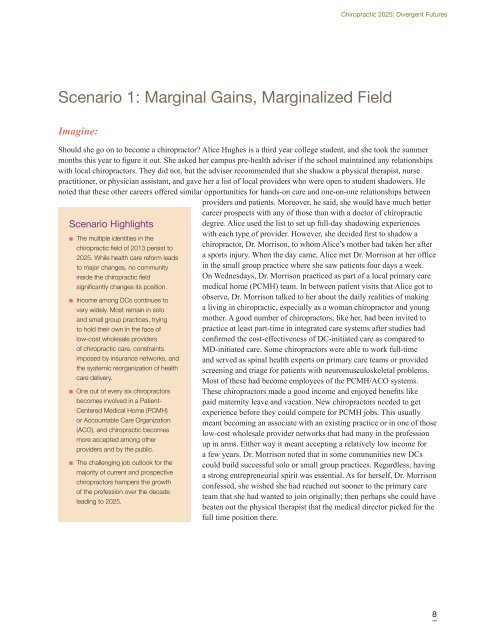Chiropractic 2025:
Chiropractic 2025:
Chiropractic 2025:
Create successful ePaper yourself
Turn your PDF publications into a flip-book with our unique Google optimized e-Paper software.
Scenario 1: Marginal Gains, Marginalized Field<br />
Imagine:<br />
<strong>Chiropractic</strong> <strong>2025</strong>: Divergent Futures<br />
Should she go on to become a chiropractor? Alice Hughes is a third year college student, and she took the summer<br />
months this year to figure it out. She asked her campus pre-health adviser if the school maintained any relationships<br />
with local chiropractors. They did not, but the advisor recommended that she shadow a physical therapist, nurse<br />
practitioner, or physician assistant, and gave her a list of local providers who were open to student shadowers. He<br />
noted that these other careers offered similar opportunities for hands-on care and one-on-one relationships between<br />
providers and patients. Moreover, he said, she would have much better<br />
career prospects with any of those than with a doctor of chiropractic<br />
Scenario Highlights<br />
■■ The multiple identities in the<br />
chiropractic field of 2013 persist to<br />
<strong>2025</strong>. While health care reform leads<br />
to major changes, no community<br />
inside the chiropractic field<br />
significantly changes its position.<br />
■■ Income among DCs continues to<br />
vary widely. Most remain in solo<br />
and small group practices, trying<br />
to hold their own in the face of<br />
low-cost wholesale providers<br />
of chiropractic care, constraints<br />
imposed by insurance networks, and<br />
the systemic reorganization of health<br />
care delivery.<br />
■■ One out of every six chiropractors<br />
becomes involved in a Patient-<br />
Centered Medical Home (PCMH)<br />
or Accountable Care Organization<br />
(ACO), and chiropractic becomes<br />
more accepted among other<br />
providers and by the public.<br />
■■ The challenging job outlook for the<br />
majority of current and prospective<br />
chiropractors hampers the growth<br />
of the profession over the decade<br />
leading to <strong>2025</strong>.<br />
degree. Alice used the list to set up full-day shadowing experiences<br />
with each type of provider. However, she decided first to shadow a<br />
chiropractor, Dr. Morrison, to whom Alice’s mother had taken her after<br />
a sports injury. When the day came, Alice met Dr. Morrison at her office<br />
in the small group practice where she saw patients four days a week.<br />
On Wednesdays, Dr. Morrison practiced as part of a local primary care<br />
medical home (PCMH) team. In between patient visits that Alice got to<br />
observe, Dr. Morrison talked to her about the daily realities of making<br />
a living in chiropractic, especially as a woman chiropractor and young<br />
mother. A good number of chiropractors, like her, had been invited to<br />
practice at least part-time in integrated care systems after studies had<br />
confirmed the cost-effectiveness of DC-initiated care as compared to<br />
MD-initiated care. Some chiropractors were able to work full-time<br />
and served as spinal health experts on primary care teams or provided<br />
screening and triage for patients with neuromusculoskeletal problems.<br />
Most of these had become employees of the PCMH/ACO systems.<br />
These chiropractors made a good income and enjoyed benefits like<br />
paid maternity leave and vacation. New chiropractors needed to get<br />
experience before they could compete for PCMH jobs. This usually<br />
meant becoming an associate with an existing practice or in one of those<br />
low-cost wholesale provider networks that had many in the profession<br />
up in arms. Either way it meant accepting a relatively low income for<br />
a few years. Dr. Morrison noted that in some communities new DCs<br />
could build successful solo or small group practices. Regardless, having<br />
a strong entrepreneurial spirit was essential. As for herself, Dr. Morrison<br />
confessed, she wished she had reached out sooner to the primary care<br />
team that she had wanted to join originally; then perhaps she could have<br />
beaten out the physical therapist that the medical director picked for the<br />
full time position there.<br />
8


